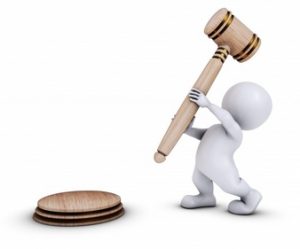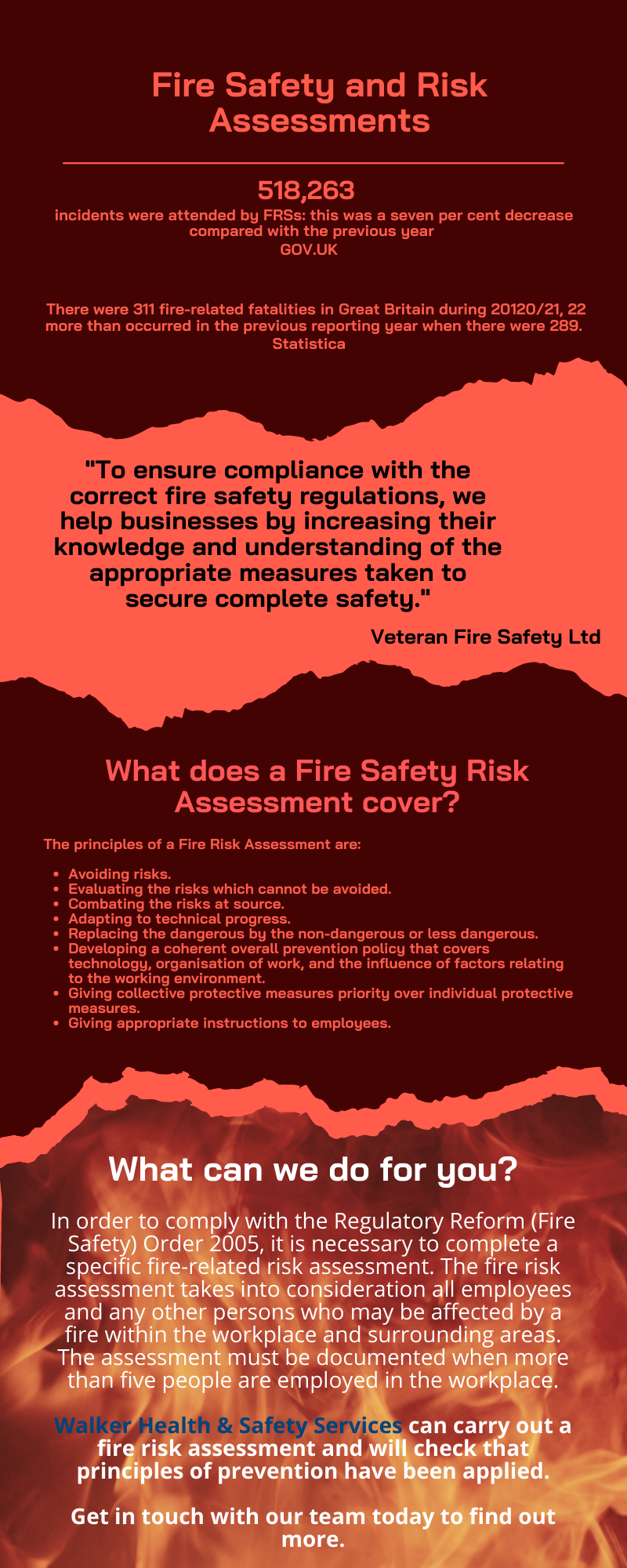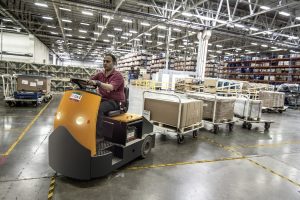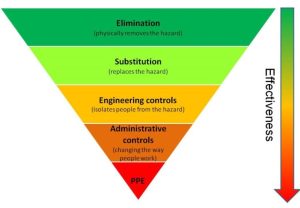
What is RIDDOR?
What is a fire risk assessment?
A fire risk assessment helps you to identify risks from fire hazards on your premises and work out what actions you need to take to make sure any risk is as low as reasonably possible.
Help with the fire risk assessment?
A responsible person must carry out and regularly review a fire risk assessment of the premises. This will identify what you need to do to prevent fire and keep people safe.
You can do the fire risk assessment yourself with the help of standard fire safety risk assessment guides. Alternatively, if you do not have the expertise or time to do the fire risk assessment yourself you need to appoint a ‘competent person’ to help, contact us for further details.
You’ll need to consider:
We have put together an infographic. I would recommend that you share the information with employees as it could be beneficial to them.
Contact us for further information.

Why have this talk? More than one third of accidents that killed workers in 2019–20 were from falls from height. 50% of all falls over 2 metres result in death.
What will this talk cover? The hazards faced and how to prepare if you are working at height.

Working at Height Toolbox Talk
What is working at height?
Any work situation where you could fall and injure yourself and others. So it includes working above or below ground level on platforms, trap hatches, on top of vehicles as well as ladders and roofs.
Hazards to consider when working at height
Before working at height
Safe working on roofs
Questions for employees
Contact us for further information

What is RIDDOR?
There are certain rules and regulations regarding RIDDOR, these include keeping all records up to date, having an accident book so accidents that don’t need to be reported to RIDDOR can be recorded.
There are certain rules and regulations regarding RIDDOR, these include keeping all records up to date, having an accident book so accidents that don’t need to be reported to RIDDOR can be recorded.
It is advised that RIDDOR records are kept for 5-6 years however the minimum they must be kept for is 3 years.
In October 2013, new RIDDOR regulations came into place, there were some changes, the list of ‘major injuries’ in RIDDOR 1995 was replaced with ‘Specified injuries’ in 2013.
The 1995 schedule that detailed 47 different types of industrial disease was replaced with eight categories of reportable work-related illness.
There was also a change in the types of dangerous occurrences that needed to be reported, in 2013 there were less.
In many different workplaces RIDDOR applies, In 2013 RIDDOR was revised, now it requires a responsible person to report to the enforcement agency, as well as keeping records.
A responsible person is –
The responsible person only needs to report to the HSE when a accident or incident has occurred in relation to work. So, if something happens to a worker when they are on their way home from work. It doesn’t need to be reported under RIDDOR.
RIDDOR reportable, deaths and injuries must have occurred – As a result of an accident to workers, self-employed and non-workers that has caused injury to them.
Or from a work-related accident that arise out of or in connection with work, the work itself must have contributed to the accident, as well as whether any plant, substance or equipment were involved. The condition of the workplace can also have an impact on whether an accident is reportable.
It is important to report any accidents and incidents as they are warnings that there are uncontrolled hazards that need identifying and eliminating to help prevent any more accidents in the future, or worse a serious accident that could cost someone their life.
There are certain things that don’t have to be reported under RIDDOR 2013, it is important to know what these are so that you don’t end up not making a RIDDOR report when you should have done.
Contact us for further information.

Warehouse health and safety tips
Health and safety procedures are paramount in any workplace, but warehousing roles present specific risks that all workers should be aware of. First, it’s important to note that we understand how easy it can be to to let initial training fall to the wayside as you grow in confidence and find yourself in an everyday routine – this is normal in many jobs.
However, letting your guard down in a high-risk environment can not only put you in danger, but it can also expose your colleagues to the risks of the work place too. So, it certainly pays to be educated when it comes to warehouse health and safety.
Whether you are an employer or an employee, there are certain requirements that must be met within the warehousing industry. Below are some of the main legal requirements for employers in the UK warehousing industry:
It is imperative that all aspects of health and safety training are covered by management. These include training in:
Why is training so important for warehousing staff?
Warehousing logistics are complex, and typically this type of work environment never sleeps. For this reason alone, it can be a manic environment to be in, especially if you’re not up to date with recent training strategies.
There are a huge range of benefits to training warehousing staff, not least to improve efficiency, increase staff morale and offer job fulfilment, but also to equip staff with everything they need to stay safe at work.
As we have stated, warehouses pose a plethora of risks, from moving vehicles to high objects, there is the potential for all kinds of incidents to occur, and so it is vital that every person on the premises is equipped with the skills and knowledge to safely handle any workplace eventuality.
Due to the size and layout of most warehouses, the need for up to date and accurate fire safety training is absolutely paramount. Regular fire safety assessments and subsequent training is actually a workplace requirement regardless of the industry you’re in, but in the case of warehouses which have a number of hazards, it’s even more important that this is kept on top of.
Things that must be carried out by employers, supervisors or management include:
Some important fire safety measures which should be carried out in the workplace include:
Effective and appropriate personal protective equipment (PPE) is often required as part of a larger health and safety strategy within a warehouse environment. It is important to ensure that you are wearing the appropriate attire to carry out your role, however this must be in conjunction with other measures in the case of your PPE failing.
It is a legal requirement here in the UK to supply all workers with appropriate PPE, and in a warehouse environment these can include:
Along with appropriate training in the appropriate PPE, regular risk assessments must also be carried out in the warehouse to ensure the right PPE is in place. Where new risks occur, old measures may need to be removes, and different PPE may need to be put into place.
In most warehouses in-house vehicles are an essential aspect of every day. Used typically for the safe moving and handling of goods, workers operating such vehicles are required to hold specific licenses.
Training is essential not just for those handling warehouse vehicles, but also for others who may come into contact with vehicles during their working day. Thorough training on how to use vehicles, and knowledge of best practice can help to maintain a safe environment. Here are some things to consider:
In any work environment there’s likely to be a risk of slips and trips, whether that’s in the kitchen or out on the shop floor. In a warehouse it can occur more easily due to things such as the surface of the floor, cables from vehicles or spills.
Here are some things you can do to avoid accidents from happening:
A huge part of your work in a warehouse will likely involve moving and handling large, often heavy goods. Doing so without the proper training however can lead to severe injuries, some of which can even put you out of work.
Luckily, there are simple things you can do to prevent injury from moving and handling goods, these include:
Incorrect handling can lead to a wealth of physical conditions, including the following:
As well as the way you hold yourself and handle goods in transit, the way you pack them can also make a huge difference to your physical wellbeing. Below are some of our tips for the safe packing of goods:
Health and safety aren’t as straightforward as we might like, especially in high-risk environments such as warehouses. But it’s crucial that we stay educated and up to date with both theoretical and practical training in order to stay safe at work.
If you are unsure about any aspects of today’s guide, it may be worthwhile to have a conversation with your manager about training opportunities. After all, it pays to be prepared.
Contact us for further information.

Understanding common electrical signs, symbols and labels
Electricity is an essential part of our everyday lives and is present in most, if not all, workplaces and homes. Despite its usefulness, it is dangerous, as contact with it can result in death or severe injuries. It can also cause damage to property from electrical-related fires and explosions.
Every year, approximately 1,000 accidents (30 of these fatal) at work involving electric shock or burns are reported to the Health and Safety Executive (HSE). Most fatalities are caused by contact with overhead or underground power cables. Even where electric shocks are not fatal, they can still result in permanent life-changing injuries.
Electrical-related fires are not uncommon either. In the Fire and Rescue Services statistics for England (2019/2020), there were:
Those who work directly with electricity, e.g. engineers, electricians and overhead lines staff, are at a higher risk. However, it is also a risk for other workers and the public who use electrical equipment and appliances at work and at home.
The dangers of electricity are often underestimated, especially in low-risk environments such as offices and when people are at home. The mains electrical supply in these types of environment is 230 volts, which may seem low. However, to put this into perspective, a voltage of just 50 volts is enough to cause the heart to stop and prevent breathing. Therefore, everyone must take electrical safety seriously, whether they are at work or at home.
If there is a risk of electrical injuries at work, employers have a legal duty to prevent, reduce or control the risks. It requires them to put precautions in place, e.g. providing employees with electrical safety training and information and instruction via safety signs and labels.
A hazard is something that has the potential to cause harm. Risk is the likelihood of harm occurring and the severity should it happen. Electricity is a hazard that can cause death, severe injuries and property damage, and it is a risk in almost all workplaces and homes.
The hazards present and the level of risk will depend on:
Some examples of common electrical hazards include:
Electrical accidents can occur for many different reasons, such as:
There are many precautions that can minimise electrical safety risks and far too many to mention in this article.
Some examples include:
Further information on electrical hazards and precautions can be found on the HSE’s electricity webpage and in their electrical safety guidance.
There are many different measures to prevent, control or reduce the risks of electrical hazards. Those selected must reduce the electrical risks to the lowest possible level. One of the measures used is electrical safety signs.
Before providing safety signs, employers must first look at eliminating electrical hazards wherever possible, e.g. using non-electrical equipment. If it is not possible, they should then look at other means of avoiding or controlling the risk. For example, they can substitute higher voltage equipment for lower voltage or battery-powered equipment.
Electrical safety signs are examples of administrative controls. They are lower in the hierarchy as they do not remove the hazard. However, they are still important control measures. Safety signs can reduce the risk by providing information on the hazard and giving instructions on preventing exposure.
A safety sign is defined in the Safety Signs and Signals Approved Code of Practice as “a sign providing information or instruction about safety or health at work by means of a signboard, a colour, an illuminated sign or acoustic signal, a verbal communication or hand signal”.
The purpose of safety signs is to communicate health and safety information to workers and others at risk from the hazard.
There are five main categories of safety sign:
Faulty, damaged and defective electrical equipment is a common cause of accidents and is often due to a lack of maintenance. Electrical appliances and equipment should be subject to regular maintenance to identify any issues that could create a risk to users or others. Portable appliance testing (PAT), also known as PAT testing, is an example of an effective maintenance method.
According to the HSE, PAT testing is “the term used to describe the examination of electrical appliances and equipment to ensure they are safe to use”. The Institution of Engineering and Technology (IET) refer to it as the in-service inspection and testing of electrical equipment.
PAT testing involves a combination of visual inspections and electronic tests. After an electrical item has been PAT tested, labels are often attached to indicate the test date and whether it is safe or not.
They usually contain the following information:
PAT labels do vary, and there are many different types, for example:
There is not a specific requirement for PAT labels to be a particular colour, size or shape. However, PAT labels are covered in the IET Code of Practice for In-Service Inspection and Testing of Electrical Equipment. The Code of Practice is widely accepted, and many PAT label suppliers will follow the requirements within.
The main law relating to electrical safety is the Electricity at Work Regulations 1989. These regulations place duties on employers, the self-employed and employees. It aims to prevent and reduce the risk of death and injury from electricity in the workplace.
The main requirements of the regulations are as follows:
The requirement for electrical safety signs comes under the Health and Safety (Safety Signs and Signals) Regulations 1996. Where there is a significant electrical risk that cannot be eliminated or controlled by other methods, employers must provide safety signs and maintain them by law. The Safety Signs and Signals Approved Code of Practice provides further guidance on the requirements of the regulations.
When and where to use safety signs should be based on the findings of the risk assessment. They should only be used where they can further reduce the risk. They should be clear and legible, and employers should avoid using too many signs, as it can confuse people.
To comply with the regulations, employers must also provide employees with suitable and sufficient instruction and training in the meaning of safety signs, including the measures to take in connection with them.
BS EN ISO 7010 is an international standard. According to the British Standards Institution (BSI), BS EN ISO 7010 standardises the look of safety signs and their meaning for international use and for the purposes of accident prevention, fire protection, health hazard information and emergency evacuation. The shape and colour of each safety sign and the design of the graphical symbols is according to ISO 3864 series.
ISO 7010 was introduced so that safety signs were consistent across Europe. In 2013, it became a European Normative (EN), which meant it was adopted by European Law. As a result, all member states had to adopt the standard, which included the UK. The UK has now left the EU, but BS EN ISO 7010 is the British version of the standard and still applies.
It is important to note that British Standards are not law. However, BS EN ISO 7010 is referred to in the Safety Signs and Signals Approved Code of Practice (ACOP), which provides guidelines on complying with the Health and Safety (Safety Signs and Signals) Regulations 1996. An ACOP is a legal series publication, and the HSE can use it as evidence of non-compliance with the regulations. Therefore, it is wise for employers to follow the standard with regards to their safety signs.
There is no legal requirement to carry out PAT testing, but it is an effective way of showing that electrical equipment has been effectively maintained. Maintenance is a legal requirement under the Electricity at Work Regulations 1989 and the Provision and Use of Work Equipment Regulations (PUWER) 1998. The frequency of PAT testing should always be based on the findings of a risk assessment.
There is also no legal requirement to use PAT labels, but it is recommended as it shows that the equipment has been tested, the result and the date of the test. It also provides evidence that an effective maintenance regime is in place.
There are guidelines for PAT testing, including labels, in the IET’s Code of Practice for In-service Inspection and Testing of Electrical Equipment, 5th Edition.
Electricity can kill people. It can also cause severe injuries and damage to property. Therefore, electrical safety must be taken seriously by all those who may be directly or indirectly exposed to electricity.
Electrical signs and symbols provide workers and others with information on electrical hazards and instructions on preventing harm. Labels, such as those used in PAT testing, inform people that electrical equipment and appliances are safe to use or not. Signs, symbols and labels are a useful way of communicating health and safety information to employees and others, which can reduce the risks.
Employers have many legal duties regarding electrical safety in the workplace. They should use the top options in the hierarchy of control to prevent and reduce the risks in the first instance. If this isn’t possible, safety signs can be used where the remaining risks are significant. If safety signs are used as a control measure, employers must ensure they comply with the relevant laws and standards. It is also vital to ensure that those at risk from electricity understand the message to keep themselves and others safe.
Contact us for further information.